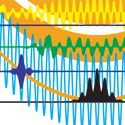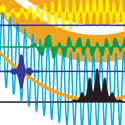Eliminating charge noise
In a paper appearing in Physical Review Letters, Jens Koch, Vladimir Manucharyan, Michel Devoret, and Leonid Glazman from Yale University in the US find a correspondence between the Cooper-pair box and its inductively shunted partner. Despite the obvious change from a discrete to a continuous spectrum of the charge operator, the excitation spectra of the two systems are found to be closely related. In particular, charging effects are observable in the dynamical response function of the inductively shunted system, which exhibits distinct peaks at frequencies governed by the spectrum of the isolated Cooper-pair box. Therefore, addressing the inductance-shunted Cooper-pair box solely by ac voltages, i.e., microwave radiation, solves the problem of realizing a stable, charge-noise-free Cooper-pair-box artificial atom. These ideas form the basis for a new type of Josephson-junction device called the fluxonium (presented by the same authors in an experimental paper, see Ref. [1]) that consists of a small junction shunted with the large inductance from a series array of large-capacitance tunnel junctions. – Sarma Kancharla
[1] V. Manucharyan, Science 326, 113 (2009).
Correction (27 November 2009): Corrections were made to the first and last sentences of the first paragraph.





